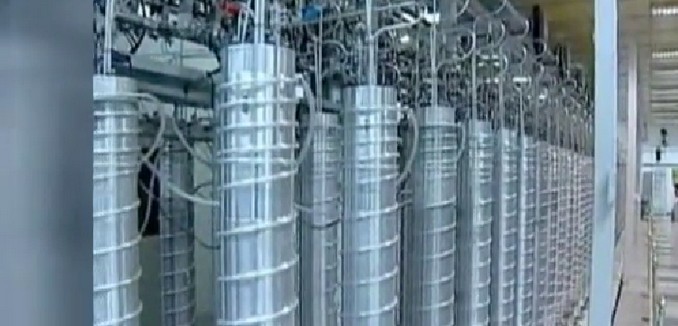A draft of a nuclear deal that would remove economic sanctions and all restrictions on Iran’s nuclear activities in as little as ten years, while allowing the country to continue operating thousands of centrifuges, has been circulating in Lausanne, Switzerland, where the negotiations between the P5+1 nation and Iran are continuing, the Associated Press (AP) reported today.
The very existence of a draft in circulation provided perhaps the clearest indication the sides were nearing a written agreement as they raced to meet a March 31 deadline for a framework pact. The deadline for a full agreement is the end of June.
Officials said the tentative deal imposes new limits on the number of centrifuges Iran can operate to enrich uranium, a process that can lead to nuclear weapons-grade material. The sides are zeroing in on a cap of 6,000 centrifuges, officials said, down from the 6,500 they spoke of in recent weeks. …
But U.S. officials insist the focus on centrifuge numbers alone misses the point. Combined with other restrictions on enrichment levels and the types of centrifuges Iran can use, Washington believes it can extend the time Tehran would need to produce a nuclear weapon to at least a year for the 10 years it is under the moratorium. Right now, Iran would require only two to three months to amass enough material if it covertly seeks to “break out” toward the bomb.
The United States originally insisted that Iran maintain no more than 1,500 centrifuges, and last year raised the limit to 4,000. 6,000 centrifuges would be sufficient if Iran plans to build a nuclear bomb, but not enough for a civilian nuclear power generation program.
The AP also reported that the remaining issues of contention in negotiations are Iran’s underground Fordow enrichment facility and its heavy water reactor at Arak. Iran insists on keeping hundreds of centrifuges working at Fordow and will re-engineer the Arak facility to produce less plutonium than originally projected. Arak will not be converted to a light water reactor capable of providing Iran with any of the radioactive isotopes it needs for research without producing plutonium, which would give it a second path to a nuclear bomb, in addition to enriched uranium.
According to the AP, among the United Nations sanctions that could be removed “within weeks” of an accord would be the weapons embargo. When Iran sends weapons to the regime of Bashar al-Assad in Syria, to Shiite militias in Iraq, or to Hezbollah in Lebanon, it violates United Nations Security Council Resolution 1747, which states that “Iran shall not supply, sell or transfer directly or indirectly from its territory or by its nationals or using its flag vessels or aircraft any arms or related materiel.”
There is no mention in the AP report that the draft limits Iran’s ballistic missile development. Iran has refused to discuss its illicit weapons program and the West has not pursued any limits to the program throughout the negotiations. Ballistic missile technology is an essential part of a nuclear weapons program as ballistic missiles are necessary as delivery systems for nuclear weapons.
The AP also doesn’t report that that nuclear deal will in any way address Iran’s sponsorship of global terror, even though its support for terror was an essential part of the Security Council resolutions passed governing Iran’s nuclear program.
According to the draft, limits on Iranian nuclear development would be in place for as little as ten years, and do not take into account the likelihood that Iran has a hidden nuclear research program. Former CIA Director Gen. Michael Hayden told a House subcommittee last November that he believed Iran is “going to build the fissile material for a weapon … at a site about which we have no knowledge.” Shortly after Hayden’s testimony, The New York Times reported that American intelligence officials assessed that “hundreds, perhaps thousands, of underground bunkers and large tunnels now honeycomb the nation.” At the time the Joint Plan of Action was signed in November 2013, a former Obama administration official told the Times “there has never been a time in the past 15 years or so when Iran didn’t have a hidden facility in construction.”
The leaked draft deal contains many of the flaws that Israeli Prime Minister Benjamin Netanyahu cautioned against in his historic speech before Congress earlier this month. Netanyahu warned that a deal that doesn’t force Iran to dismantle its nuclear infrastructure would allow a nuclear break-out time that is “very short—about a year by U.S. assessment, even shorter by Israel’s.” Saying that Iran was skilled at playing “hide and cheat,” Netanyahu quoted a former International Atomic Energy Agency official who said, “If there’s no undeclared installation today in Iran, it will be the first time in 20 years that it doesn’t have one.” Given the very strong likelihood that Iran has hidden nuclear facilities and that the deal would leave its nuclear infrastructure intact, Netanyahu warned, “That concession creates a real danger that Iran could get to the bomb by violating the deal.”
Netanyahu said that the sunset clause, the expiration of all restrictions on Iran’s nuclear program after ten years, “creates an even greater danger that Iran could get to the bomb by keeping the deal.” If Iran would reach Ayatollah Ali Khamenei’s aspirations of operating 190,000 centrifuges once the restrictions expire, then Iran “could make the fuel for an entire nuclear arsenal and this in a matter of weeks, once it makes that decision.”
Yesterday, Bloomberg News reported that the administration now characterizes Iran’s testing of an advanced centrifuge last year as a “mistake,” not cheating.
[Photo: euronews (in English) / YouTube ]




